Skillful Out-leakage Detection
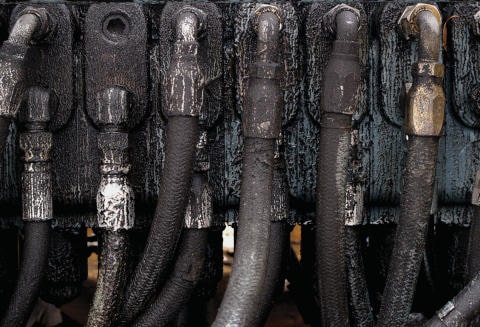 This is the most common form of leakage. It is also known as external leakage. Out-leakage relates to a failure of containment. Typically, liquids or gases follow the path of least resistance, going from high pressure to lower pressure. A crack, clearance, orifice or unsealed space becomes the leakage path through which the fluid, gas or even solids (aggregate) exit to the surrounding environment.
This is the most common form of leakage. It is also known as external leakage. Out-leakage relates to a failure of containment. Typically, liquids or gases follow the path of least resistance, going from high pressure to lower pressure. A crack, clearance, orifice or unsealed space becomes the leakage path through which the fluid, gas or even solids (aggregate) exit to the surrounding environment.
The machines most prone to oil leakage are compressors, process pumps, engines and hydraulic systems. Think of an automobile engine, the product of billions of dollars of engineering advancements spanning more than a century. As sophisticated as it might be, we still see the ubiquitous presence of oil and coolant leakage on the pavement of garages and parking lots. We, therefore, must depend heavily on early detection and prompt corrective action to keep leakage under control.
For certain machines and production processes, out-leakage can result in the contamination of the product being produced (food, beverage, paper, etc.). Hydraulic systems, due to their high pressures, are the most prone to leakage, which can occur in multiple locations but is usually seen at fittings, hoses, dynamic seals and static seals. Seals used to control out-leakage are called retention seals. Many seals attempt to serve both functions of retention and exclusion.
Visual Out-leakage Detection
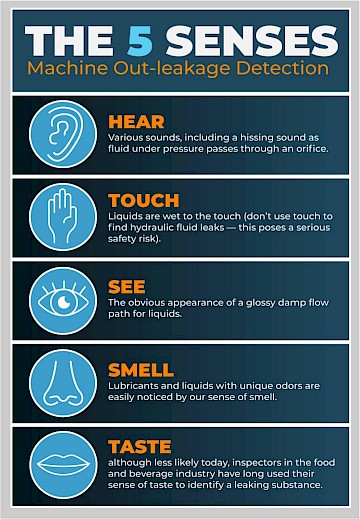 External leakage is the easiest to identify in most cases. When a piece of equipment is inspected, the area around it serves as a tell-tale sign of an active lubricant leak. There may be a small drip of oil coming from a drain valve or a puddle of oil surrounding the machine that would indicate a mechanical or fluid level issue. However, determining the source of an external leak can be difficult.
External leakage is the easiest to identify in most cases. When a piece of equipment is inspected, the area around it serves as a tell-tale sign of an active lubricant leak. There may be a small drip of oil coming from a drain valve or a puddle of oil surrounding the machine that would indicate a mechanical or fluid level issue. However, determining the source of an external leak can be difficult.
When diagnosing a leaky system, first look for reasons that may cause the leak. For instance, leaks are often triggered by pressure build-up. Check for plugged vents, overfilling and elevated heat levels. Stress from too much torque can result in gasket failures that lead to leaks. Seal failures are often caused by misalignment.
Leakage is a fault and compromises machine reliability and all the consequences of failure (plus a few more). As such, the P-F Interval clearly applies. Everything maintenance and inspection resources can do to extend the P-F Interval to allow for safe and convenient remediation is justified. To do this, we need to ask why. Why did the leak occur, and why was it allowed to advance?
How to Find the Source of an Oil Leak
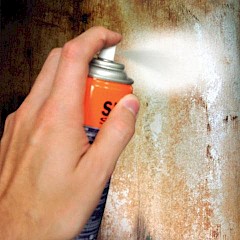 One way to find the source of a tough-to-trace oil a leak is to start by cleaning the area - you can use a fast-dry solvent like break cleaner. Next, spray the area with an aerosol such as athlete’s foot powder (baby powder can also be used). The powder sticks to almost any surface, and the oil will leave a trail through the powder right to the source of the leak. A thermal imaging IR camera will also show hot oil or grease oozing out of the source.
One way to find the source of a tough-to-trace oil a leak is to start by cleaning the area - you can use a fast-dry solvent like break cleaner. Next, spray the area with an aerosol such as athlete’s foot powder (baby powder can also be used). The powder sticks to almost any surface, and the oil will leave a trail through the powder right to the source of the leak. A thermal imaging IR camera will also show hot oil or grease oozing out of the source.
Detect Steam and Air Using Ultrasound
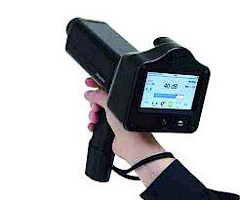 Ultrasound instruments are versatile. Because they use sound to detect leaks, they can be used to detect multiple kinds of leaks, including leaks in liquid systems, gas systems and vacuum systems, as well as internal or external leaks.
Ultrasound instruments are versatile. Because they use sound to detect leaks, they can be used to detect multiple kinds of leaks, including leaks in liquid systems, gas systems and vacuum systems, as well as internal or external leaks.
Ultrasound instruments are often used to save energy by locating compressed air and steam leaks. Compressed air is a costly utility, and according to the Department of Energy, around 30% of all compressed air produced in the United States is lost as a result of leakage. It’s a similar story with steam, another costly utility. Besides being a waste of energy, steam leaks also present the threat of water hammer, which can increase operating costs by damaging steam system components.
UV/Dye Detection of Oil Leaks
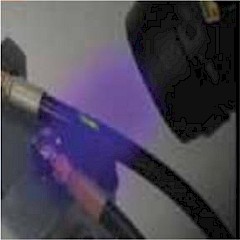 Fluorescent dyes are sometimes used with UV lamps to trace the pathway of the streaming liquid to its origin. This requires first wiping down the machine, followed by introducing the dye to the fluid reservoir inside the machine. By reducing ambient light, a UV lamp is often very effective at detecting the leak source. Once detected, the leak source should be immediately tagged.
Fluorescent dyes are sometimes used with UV lamps to trace the pathway of the streaming liquid to its origin. This requires first wiping down the machine, followed by introducing the dye to the fluid reservoir inside the machine. By reducing ambient light, a UV lamp is often very effective at detecting the leak source. Once detected, the leak source should be immediately tagged.
